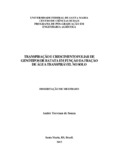| dc.creator | Souza, André Trevisan de | |
| dc.date.accessioned | 2012-12-03 | |
| dc.date.available | 2012-12-03 | |
| dc.date.issued | 2012-02-28 | |
| dc.identifier.citation | SOUZA, André Trevisan de. TRANSPIRATION AND LEAF GROWTH OF POTATO GENOTYPES AS A
FUNCTION OF FRACTION OF TRANSPIRABLE SOIL WATER. 2012. 92 f. Dissertação (Mestrado em Engenharia Agrícola) - Universidade Federal de Santa Maria, Santa Maria, 2012. | por |
| dc.identifier.uri | http://repositorio.ufsm.br/handle/1/7550 | |
| dc.description.abstract | The objective of this study was to determine the response of transpiration and leaf growth to
the fraction of transpirable soil water (FTSW), in three clones (SMINIA 02106-11, SMINIA
00017-6 and SMINIA 793101-3) of Potato Genetic and Breeding Program of the Federal
University of Santa Maria, adapted to subtropical and temperate conditions of cultivation and
the cultivar Asterix. Two experiments were conducted in a greenhouse in Santa Maria, in the
Spring, with planting in 08/09/2010 and on the Fall, with planting on 01/04/2011. The
available water, represented by FTSW, transpiration and leaf growth were measured on a
daily basis, in each experiment, during the period of soil drying. The threshold FTSW that
begins to affect transpiration, indicating the beginning of stomatal closure, was 0.36, 0.38,
0.41 and 0.29 for clones SMINIA 02106-11, SMINIA 00017-6, SMINIA 793101-3 and
Asterix, respectively in the first period and 0.26, 0.27, 0.21 and 0.22 in the second period,
indicating that the cultivar Asterix is less tolerant to soil water deficit cultivation in the spring
than advanced clones. The threshold FTSW that begins to affect leaf growth was higher than
for transpiration, 0.44, 0.40, 0.46 and 0.47 in the first experiment to SMINIA 02106-11,
SMINIA 00017-6, SMINIA 793101-3 and Asterix, respectively, and 0.27, 0.38, 0.29 and 0.26
in the second experiment. These results confirm the genetic variability of the potato, and
shows that each genotype is related in a way with the environment.
Keywords: Solanum tuberosum. Drought tolerance. Water stress. | eng |
| dc.description.sponsorship | Coordenação de Aperfeiçoamento de Pessoal de Nível Superior | |
| dc.format | application/pdf | por |
| dc.language | por | por |
| dc.publisher | Universidade Federal de Santa Maria | por |
| dc.rights | Acesso Aberto | por |
| dc.subject | Solanum tuberosum | por |
| dc.subject | Tolerância à seca | por |
| dc.subject | Estresse hídrico | por |
| dc.subject | Solanum tuberosum | eng |
| dc.subject | Drought tolerance | eng |
| dc.subject | Water stress | eng |
| dc.title | Transpiração e crescimento foliar de genótipos de batata
em função da fração de água transpirável no solo | por |
| dc.title.alternative | Transpiration and leaf growth of potato genotypes as a
function of fraction of transpirable soil water | eng |
| dc.type | Dissertação | por |
| dc.description.resumo | O objetivo deste trabalho foi determinar a resposta da transpiração e do crescimento ao
conteúdo de água disponível no solo, representado pela fração de água transpirável no solo
(FATS), em três clones avançados (SMINIA 00017-6, SMINIA 02106-11 e SMINIA 793101-
3) do Programa de Genética e Melhoramento de Batata da Universidade Federal de Santa
Maria, adaptados as condições subtropicais e temperadas de cultivo e da cultivar Asterix.
Foram realizados dois experimentos em casa de vegetação em Santa Maria, RS, na primavera
(cultivo de safra), com plantio em 08/09/2010 e no outono (cultivo de safrinha), com plantio
em 01/04/2011. A água disponível, representada pela FATS, a transpiração e o crescimento
foliar foram medidos diariamente durante o período de imposição da deficiência hídrica. A
FATS crítica que começa a afetar a transpiração, indicativo do início do fechamento
estomático, foi de 0,36, 0,38, 0,41 e 0,29 para os clones SMINIA 02106-11, SMINIA 00017-
6, SMINIA 793101-3 e Asterix, respectivamente no primeiro experimento e 0,26, 0,27, 0,21 e
0,22 no segundo experimento, indicando que a cultivar Asterix é menos tolerante ao déficit
hídrico no solo no cultivo de primavera que os clones avançados. Já a FATS crítica que
começa a afetar o crescimento foliar foi maior que para a transpiração, 0,44, 0,4, 0,46 e 0,47
no primeiro experimento para SMINIA 02106-11, SMINIA 00017-6, SMINIA 793101-3 e
Asterix, respectivamente, e 0,27, 0,38, 0,29 e 0,26 no segundo experimento. Estes resultados
confirmam a variabilidade genética da batata, e mostram que cada genótipo se relaciona de
uma forma com o ambiente. | por |
| dc.contributor.advisor1 | Heldwein, Arno Bernardo | |
| dc.contributor.advisor1Lattes | http://buscatextual.cnpq.br/buscatextual/visualizacv.do?id=K4788078U3 | por |
| dc.contributor.referee1 | Dalmago, Genei Antonio | |
| dc.contributor.referee1Lattes | http://buscatextual.cnpq.br/buscatextual/visualizacv.do?id=K4795371Y6 | por |
| dc.contributor.referee2 | Righi, Evandro Zanini | |
| dc.contributor.referee2Lattes | http://buscatextual.cnpq.br/buscatextual/visualizacv.do?id=K4761177E5 | por |
| dc.creator.Lattes | http://lattes.cnpq.br/7861137180185554 | por |
| dc.publisher.country | BR | por |
| dc.publisher.department | Engenharia Agrícola | por |
| dc.publisher.initials | UFSM | por |
| dc.publisher.program | Programa de Pós-Graduação em Engenharia Agrícola | por |
| dc.subject.cnpq | CNPQ::CIENCIAS AGRARIAS::ENGENHARIA AGRICOLA | por |


